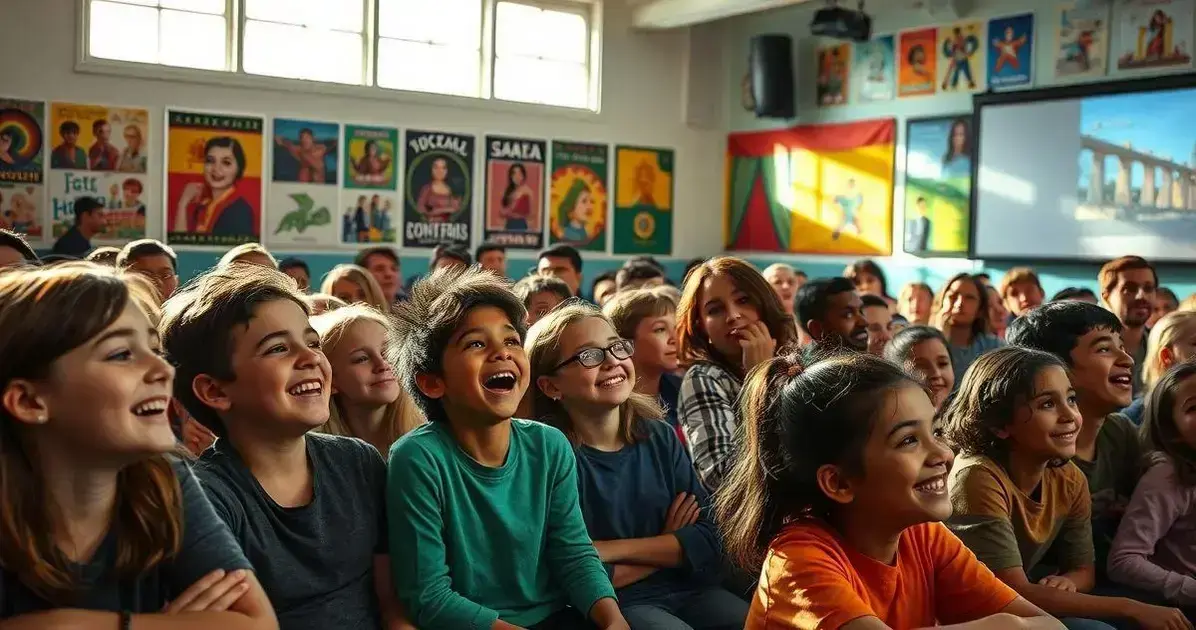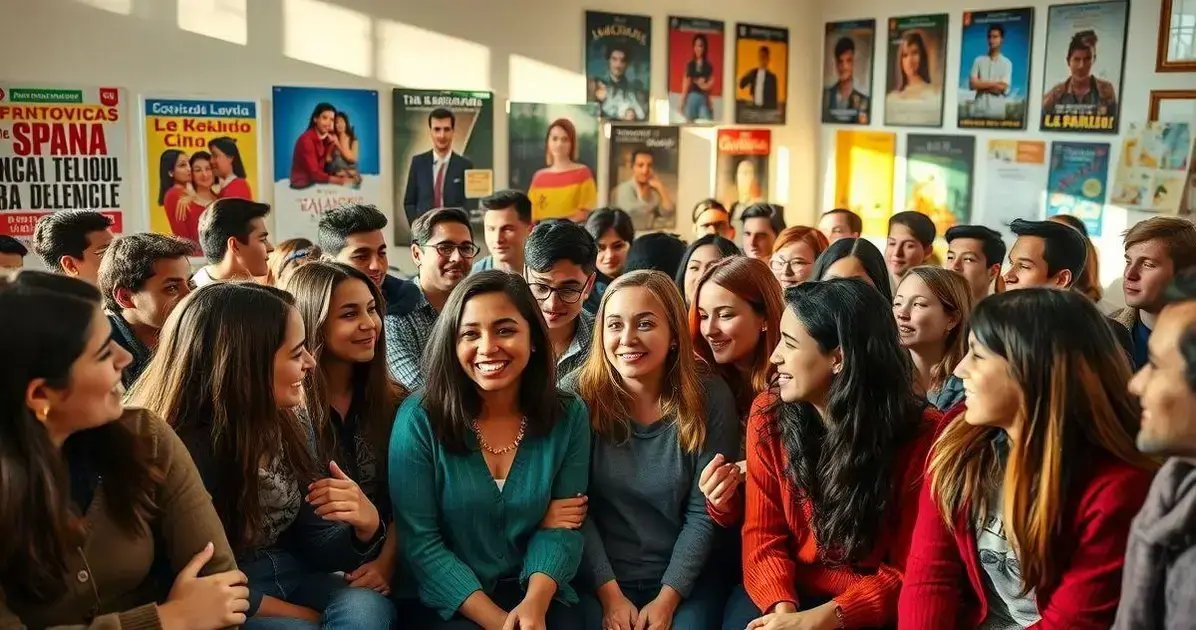Movies to Show in Spanish Class are an exciting way to bring the language to life. By incorporating films, students not only learn vocabulary but also get immersed in the culture of Spanish-speaking countries. The right movies can make learning both engaging and memorable.
From captivating stories to rich cultural references, movies offer a dynamic approach to language learning. They present real-life situations, authentic dialogue, and the diverse accents students may encounter in the Spanish-speaking world. This makes them a powerful tool in enhancing listening and comprehension skills.
Ready to dive deeper into the top films for your classroom? Keep reading to discover which movies will keep your students motivated and connected to the language!
Top 10 Movies to Show in Spanish Class
Movies are an exciting way to teach language and culture. Here are the top 10 movies to show in Spanish class that are perfect for engaging students:
- Como Agua Para Chocolate – This film beautifully combines love and food, making it both culturally rich and entertaining.
- El Laberinto del Fauno – A dark fantasy set post-Civil War Spain; it provides cultural insights into Spanish history.
- Y Tu Mamá También – A coming-of-age film that explores themes of friendship and social issues in Mexico.
- Coco – A family-friendly animated film that celebrates Mexican traditions surrounding the Day of the Dead.
- Vida Nueva – A touching story about family challenges, showcasing everyday life in a Spanish-speaking country.
- Mar adentro – This film tackles sensitive topics around life and death, stimulating profound discussions.
- Vivir es fácil con los ojos cerrados – A heartwarming journey that also serves as a window into the 1960s Beatles influence in Spain.
- Los ojos de Julia – A gripping thriller that can boost vocabulary and comprehension skills through suspenseful storytelling.
- Frida – A biographical film about the artist Frida Kahlo, enriching students’ understanding of art and culture.
- Mi Vida Loca – This film serves as an interactive learning tool, complete with Spanish-language lessons embedded within.
Why Movies Enhance Language Learning
Using films in language classes is a powerful tool. Here are some reasons why movies enhance language learning:
- Visual Context: Movies provide a rich visual context. Seeing characters interact in different situations helps students understand vocabulary and phrases better.
- Authentic Language: Films use real-life dialogue. This exposure helps students learn slang, idiomatic expressions, and pronunciation that textbooks often miss.
- Cultural Insights: Movies showcase the culture of Spanish-speaking countries. Understanding cultural references and social contexts makes language learning feel more authentic.
- Emotional Engagement: Films evoke emotions. When students feel connected to the story, they are more likely to remember words and phrases associated with their feelings.
- Listening Skills: Watching movies helps improve listening comprehension. Students hear natural speech patterns and diverse accents, enhancing their overall listening skills.
- Discussion Starters: Movies generate conversations. After watching, students can discuss plot, characters, and themes, allowing them to practice speaking and critical thinking.
- Motivation: Films make learning fun! Students are often more excited and engaged when they can watch a movie instead of just reading from a textbook.
Cultural Significance of Spanish Films

Cultural significance of Spanish films extends beyond entertainment. These movies provide a window into the lives, traditions, and issues of Spanish-speaking countries. Here are key points highlighting their importance:
- Historical Reflection: Many Spanish films depict significant historical events. They offer viewers insights into the cultural heritage and struggles faced by these societies.
- Representation of Diversity: Spanish-speaking countries are diverse. Films showcase various cultures, dialects, and lifestyles, allowing students to appreciate this richness.
- Exploration of Social Issues: Spanish films often address social topics such as immigration, poverty, and identity. This opens discussions about real-world challenges and promotes empathy.
- Connection to Literature: Many Spanish films are adaptations of classic literature. This connection helps students engage with important literary works while learning the language.
- Promotion of Artistic Expression: Spanish cinema is known for its unique artistic styles and storytelling methods. Students can learn about creative techniques and filmmaking styles.
- Influence of Music and Dance: Music and dance play significant roles in Spanish culture. Films often highlight traditional forms, enriching students’ linguistic and cultural knowledge.
- Cultural Pride: Spanish films celebrate cultural identity. They foster pride and understanding of one’s heritage, inspiring students to take interest in their own cultures.
How to Choose the Right Movie for Your Class
Choosing the right movie for your Spanish class is crucial for effective learning. Here are some tips on how to choose the right movie for your students:
- Know Your Audience: Consider the age and language proficiency of your students. Select films that match their interests and language skills.
- Focus on Themes: Choose movies that align with your lesson plans. Themes like friendship, family, or adventure can spark meaningful discussions.
- Cultural Relevance: Look for films that provide insights into Spanish-speaking cultures. This enriches the learning experience and broadens students’ horizons.
- Length and Pace: Consider the movie’s length and pacing. Shorter films or segments can be more digestible for students to keep their attention.
- Availability of Subtitles: Select movies that offer subtitles in Spanish or English. This helps students follow along and improves their comprehension.
- Content Sensitivity: Be aware of sensitive topics. Ensure the movie’s content is appropriate for your classroom environment and does not offend any students.
- Reviews and Ratings: Check reviews from educators and ratings on educational websites. This can guide you towards films that are deemed effective for learning.
Engaging Activities to Pair with Movies
To make the most out of films in the classroom, pairing them with engaging activities is essential. Here are some engaging activities to pair with movies:
- Vocabulary Worksheets: Create worksheets with key vocabulary from the film. This helps students familiarize themselves with important words and phrases.
- Discussion Questions: Prepare questions that encourage students to think critically about the movie. Discuss themes, character motivations, and cultural aspects.
- Character Journals: Ask students to write journal entries from the perspective of a character. This fosters empathy and deeper understanding of the storyline.
- Scene Reenactments: Have students act out pivotal scenes. This not only boosts creativity but also enhances speaking and listening skills.
- Soundtrack Analysis: Explore the movie’s soundtrack. Discuss how music complements the film and its emotional impact, linking concepts to cultural context.
- Cultural Research Projects: Let students pick a cultural element featured in the film and research it. They can present their findings to the class, promoting cross-cultural awareness.
- Film Reviews: After watching the movie, ask students to write short reviews. This activity sharpens their writing skills and promotes skillful expression of opinions.
Student Feedback on Movies in Class

Understanding student feedback on movies in class is vital for improving the learning experience. Here are some insights into what students think about using films in their Spanish classes:
- Increased Engagement: Many students report that movies make classes more enjoyable. They feel more engaged watching a film rather than just reading.
- Better Understanding: Films help students grasp the language better. They mention that visual stories make it easier to understand vocabulary and grammar in context.
- Cultural Connection: Students appreciate learning about different cultures through films. They feel that movies help them connect with Spanish-speaking communities.
- Improved Listening Skills: Feedback shows that students find movies helpful for developing listening skills. They enjoy hearing natural conversations and diverse accents.
- Fun Learning Environment: Many students express that watching movies creates a relaxed atmosphere. This encourages them to participate more actively in discussions.
- Desire for Variety: While students enjoy films, they also want a mix of movie genres. They appreciate when teachers include comedies, dramas, and animated films.
- Suggestions for Improvement: Some students suggest that movies paired with interactive activities, like discussions and games, would enhance their learning experience even more.
Making the Most of Film Discussions
Making the most of film discussions enhances students’ understanding and enjoyment of the material. Here are some effective strategies for making the most of film discussions in your Spanish class:
- Set Clear Objectives: Before the film, explain the goals of the discussion. Let students know what themes, vocabulary, or cultural elements they should pay attention to.
- Encourage Open Dialogue: Create an environment where students feel comfortable sharing their thoughts. Encourage them to express their opinions and ask questions about the film.
- Use Guided Questions: Prepare discussion questions that prompt critical thinking. For example, ask students how a character’s choice affects the plot or what cultural insights they gained.
- Incorporate Group Work: Divide students into small groups for discussion. This can help quieter students feel more comfortable sharing their thoughts. Each group can later present their insights to the class.
- Connect to Real-Life Experiences: Encourage students to relate themes from the film to their own lives. This connection can deepen their understanding and make discussions more relevant.
- Celebrate Diverse Perspectives: Remind students that different viewpoints enrich discussions. Encourage them to respect each other’s opinions and consider perspectives beyond their own.
- Follow Up with Written Reflections: After the discussion, ask students to write down their thoughts. This can help them process what they’ve learned and reflect on their contributions.
FAQ – Frequently Asked Questions about Movies to Show in Spanish Class
What are the benefits of showing movies in Spanish class?
Movies enhance language learning by providing visual context, authentic language, and cultural insights.
How can I choose the right movie for my class?
Consider your students’ age, language proficiency, and interests. Make sure the film aligns with your lesson themes.
What engaging activities can I pair with movies?
Activities like vocabulary worksheets, character journals, and discussion questions can enhance the learning experience.
How do students feel about watching movies in class?
Many students enjoy watching movies as they find them engaging and helpful for understanding the language and culture.
What strategies can I use for film discussions?
Setting clear objectives, using guided questions, and encouraging open dialogue can make discussions more effective.
How do films promote cultural understanding?
Films provide insights into the customs, values, and societal issues of Spanish-speaking cultures, enriching students’ perspectives.